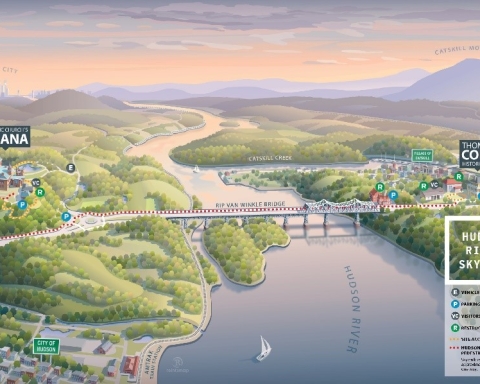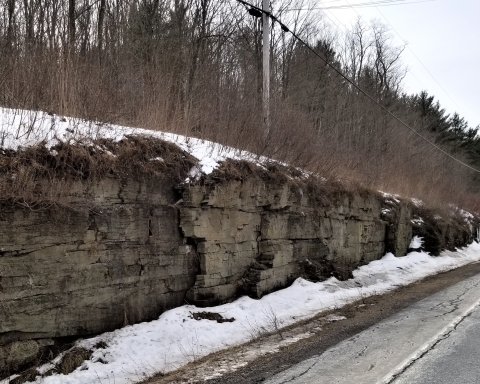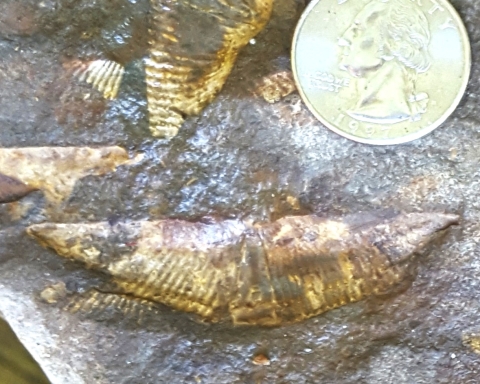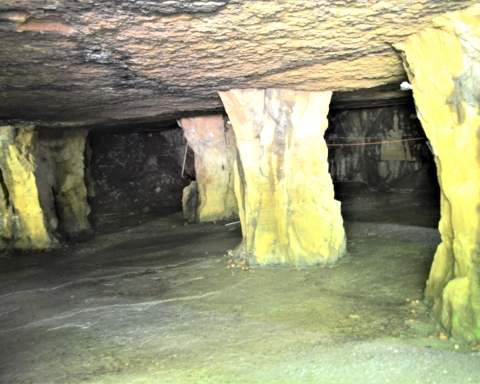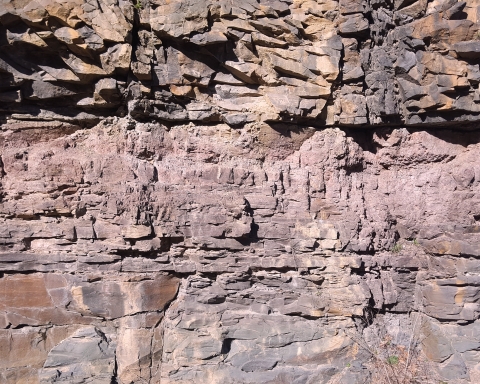Visions of an Art Trail past – Kaaterskill Clove
On The Rocks
The Woodstock Times
Feb. 28, 2013
Robert and Johanna Titus
We have been touring the new Hudson River School Art Trail, visiting those sites where so many of those paintings were inspired. We admire the great artists of the Hudson Valley. We revere the canvases that they painted and the creativity that they brought to our country. We are proud that they worked here, where we have chosen to live. It is a thrill for us to stand where they stood and see what they saw as we travel though the landscapes of our Catskills and Hudson Valley. But, is it arrogance when we claim that we can see what they couldn’t? Or is it the privilege that comes with gaining a hard earned knowledge of our region’s ice age history? Whatever, we believe that all those who share our pleasure in the great art that was painted here would benefit greatly from understanding the ice age history that preceded it and, we think, made it all possible. Today we visit Kaaterskill Clove, site number four on the Art Trail.
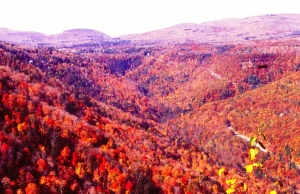
The clove has long invited visitors; there has, it would seem, always been a path ascending it, probably stretching back well into human prehistory. This massive canyon has always been a magnet for artists; Thomas Cole painted it in the 1820s and established his reputation here. Palenville came to be an artist colony long before Woodstock. There was so much to paint.
This great canyon surely belongs somewhere in the American West; it seems too grand to be an eastern landscape. Its measurements are worthy of the Rockies; it is four miles long, almost two miles wide and roughly 2000 feet deep. Its many trails have, for generations, carried hikers to an abundance of scenic views, some wide and awesome, others intimate and of delicate beauty.
It is, every inch of it, the product of the Ice Age. Whole episodes of glaciation have passed by here and each culminated in powerful rushes of water from melting ice. Masses of glacial meltwater provided torrents of erosive might that pounded down the growing canyon and sculpted its awesome landscape. There must have been many days when the flows from high above competed to set new standards for a watery violence as they thundered down the canyon. Such days, warm by ice age standards, generated raging cascades of frightening power. The canyon must have frequently echoed with a truly resounding, hammering, violent cacophony of ear-splitting noise. Hollywood could not have portrayed what must have passed down this canyon. But are we guilty of an excessive and sensational exercise of purple prose? No, we are not exaggerating; this was the unrestrained Nature that carved Kaaterskill Clove.
But we choose to visit the clove during what may have been its quietest moment ever.
We visit it at the peak of one of the last advances of the ice, about 16,000 years ago. We are geologists; we get to pick all the exact dates and the exact times for our journeys. After all, we can sort through thousands of calendar dates and moments, looking for just the right one. After much pondering we have selected a 2:00 AM on a late January night, towards the end of one of the last advances of the ice. We are the mind’s eye and we can do this sort of thing. Our trek begins with us drifting down the Hudson Valley. High above is a full moon. Below is the ice of the glacier that presently fills that valley.
The moon, reflecting off the ice, provides a brilliance of illumination that is rarely matched in our modern world. We look down and see an almost luminous ice, broken by jet black crevasses. The curved nature of those fractures betrays recent movements of the glacier, but there is no such motion tonight. The temperature is a minus 30 degrees Fahrenheit. It’s been cold like that for weeks and the ice has frozen solid and ground to a complete halt. We did, after all, get to pick the time and the date, and we aimed for extremes.
We drift down the valley to where, someday, there will be a Palenville and we turn west and enter this ice age version of Kaaterskill Clove. It has reached midnight and the full moon hangs high in the sky. It again illuminates an ice age scene; now we can see a stream of ice that has turned west and entered the clove. It actually rises up the clove; ice can flow uphill when pushed from behind. We too drift westward and we decide to come to a halt and hang in the air, only a few hundred feet above the glacier.
It is a perfectly still night, with not the slightest breath of air. We hang in the sky and we can feel the cold. But we can, it would seem, also feel the complete silence as well. On some other less frigid night the ice would be moving and making all sorts of a racket, but not on this night; it is so completely hushed.
Above the glacier, cliffs rise up toward the top of the clove. There had been some warmer weather in earlier months and water melted out of the fractured rocks and then briefly drenched those cliffs. But tonight all that lies frozen into immense icicles. The moonlight now illuminates these hangings; they form ghostly draperies all around the walls of the canyon.
We are the mind’s eye; we can go anywhere and do anything. Now we choose to rocket high up into this Arctic sky. As we ascend, a great glacial landscape opens up all around. To the west all of the Catskills lie blanketed in thick ice. It catches the moonlight and reflects it with a brilliant sheen. Behind us, the Hudson Valley is not quite filled with ice. Numerous depressions and crevasses break up its image into a blocky mix of gray and black. Beyond we see the skyline of the Taconic Mountains, shining, almost silvery, against the starry black night. We slowly turn a full 360 degrees in this glacial nocturne. We are not arrogant; we are humbled and privileged by what we see.
Nobody painted this scene.
Reach the authors at randjtitus@prodigy.net Join their facebook page “The Catskill Geologist.”

